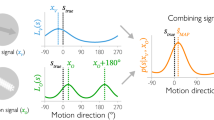Abstract
Energy filters are tuned to space-time frequency orientations. In order to compute velocity it is necessary to use a collection of filters, each tuned to a different space-time frequency. Here we analyze, in a probabilistic framework, the properties of the motion uncertainty. Its lower bound, which can be explicitly computed through the Cramér-Rao inequality, will have different values depending on the filter parameters. We show for the Gabor filter that, in order to minimize the motion uncertainty, the spatial and temporal filter sizes cannot be arbitrarily chosen; they are only allowed to vary over a limited range of values such that the temporal filter bandwidth is larger than the spatial bandwidth. This property is shared by motion sensitive cells in the primary visual cortex of the cat, which are known to be direction selective and are tuned to spacetime frequency orientations. We conjecture that these cells have larger temporal bandwidth relative to their spatial bandwidth because they compute velocity with maximum efficiency, that is, with a minimum motion uncertainty.
Similar content being viewed by others
References
Adelson EH, Bergen JR (1985) Spatiotemporal energy models for the perception of motion. J Opt Soc Am A 2:284–299
Adelson EH, Movhon JA (1982) Phenomenal coherence of moving visual patterns. Nature 300:523–525
Ahumada AJ, Watson AB (1985) Model of human visual-motion sensing. J Opt Soc Am A 2:322–341
Barlow HB, Levick WR (1965) The mechanism of directional selectivity in the rabbit's retina. J Physiol 178:447–504
Bracewell R (1965) The Fourier transform and its applications. McGraw-Hill, New York
Daugman J (1985) Uncertainty relation for resolution in space, spatial frequency, and orientation optimized by two-dimensional visual cortical filters. J Opt Soc Am A 2:1160–1169
Fleet DJ, Jepson AD (1985) On the hierarchical construction of orientation and velocity selective filters. University of Toronto Technical Report RBCV-TR-85-8
Galli L et al. (1988) The organization of receptive fields in area 18 neurons of the cat varies with spatio-temporal characteristics of the visual stimulus. Exp Brain Res 71:1–7
Grzywacz NM, Yuille AL (1990) A model for the estimates of local image velocity by cells in the visual cortex. Proc R Soc Lond B 239:129–161
Heeger DJ (1988) A model for the extraction of image flow. J Opt Soc Am A 4:1455–1471
Hildreth EC (1984) The measurement of visual motion. MIT Press, Cambridge Mass
Holub RA, Morton-Gibson M (1981) Response of visual cortical neurons of the cat to moving sinusoidal gratings: response-contrast functions and spatiotemporal interactions. J Neurophysiol 46:1244–1259
Jasinschi RJ (1988) Space-time sampling with motion uncertainty: constraints on space-time filtering. Proceedings of the second International Conference on Computer Vision, IEEE Computer Society, Washington DC pp 428–434
Kulikowski JJ, et al. (1982) Theory of spatial position and spatial frequency relations in the receptive fields of simple cells in the visual cortex. Biol Cybern 43:187–198
Mikami A et al. (1986) Motion selectivity in the macaque visual cortex. II. Spatiotemporal range of directional interactions in MT and VI. J Neurophysiol 55:1328–1339
Movshon JA (1975) The velocity tuning of single units in cat striate cortex. J Physiol 249:445–468
Nakayama K, Silverman GH (1988) The aperture problem-I. Perception of nonrigidity and motion direction in translating sinusoidal lines Vision Res 28:739–746
Papoulis A (1965) Probability, random variables, and stochastic processes. McGraw-Hill, New York
Poggio T, et al. (1985) Computational vision and regularization theory. Nature 317:314–319
Poggio T, Reichardt WE (1973) Considerations on models of movement detection. Kybernetik 13:223–227
Reichardt WE, Hassenstein B (1956) Systemtheoretische Analyse der Zeit-, Reihenfolgen- und Vorzeichenauswertung bei der Bewegungsperzeption des Rüsselkafers Chlorophasus. Z Naturforsch 11b:513–524
Sperling G, van Santen JPH (1984) Temporal covariance model of human motion perception. J Opt Soc Am A 1:451–473
VanTrees HL (1968) Detection, estimation and modulation theory, Part I. Wiley, New York
Author information
Authors and Affiliations
Rights and permissions
About this article
Cite this article
Jasinschi, R.S. Energy filters, motion uncertainty, and motion sensitive cells in the visual cortex: a mathematical analysis. Biol. Cybern. 65, 515–523 (1991). https://doi.org/10.1007/BF00204665
Received:
Accepted:
Issue Date:
DOI: https://doi.org/10.1007/BF00204665




